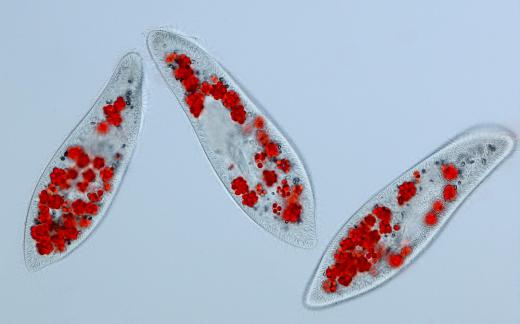What is the Difference Between Protozoans and Metazoans?
 Michael Anissimov
Michael Anissimov
The difference between protozoans and metazoans is that protozoans are unicellular organisms while metazoans are multicellular. The definition of metazoans is relatively clear for most examples, as are protozoans, though both have fuzzy edges. The term "protozoa" (meaning "first animals") refers to any animal-like unicellular organism, while plant-like unicellular organisms are called algae. But there are organisms that blur the two: for instance, the algae Dinobryon has chloroplasts, but it can also move around and feed on organic matter. Many ostensibly unicellular organisms also arrange themselves into thread-like or spherical colonies, such as cyanobacteria or the chrolophyte Volvox.
The term "protozoan" basically covers any unicellular organism that is not an animal, plant, bacteria, or fungi. By definition, every member of kingdom Animalia is multicellular, and another name for the kingdom is in fact Metazoa. Stationary photosynthetic unicellular organisms are not protozoans in part because the suffix -zoa means animal, and these are clearly not at all animal-like. Protozoans are always motile, as there are no protozoans that can survive by stationary filter-feeding, in contrast to the numerous animals such as sponges, corals, barnacles, limpets, and brachiopods that do so.

Protozoans range in size from 10–50 microns (millionths of a meter), but a few species are as large as 1 mm. Metazoans range from about 50 microns, as in the smallest copepods, to the Blue Whale (34 m or 111 ft), Lion's mane jellyfish (36.5 m or 120 feet), and bootlace worm (55 m or 180 ft). The extinct dinosaur Amphicoelias fragillimus may have been 60 m (197 ft) or longer. So as we see, the largest metazoans may be as much as a million times larger than a typical protozoan, though most metazoans are small in size, less than a mm in length. Macroscopic metazoans such as humans are in the minority.

It is thought that metazoans evolved from protozoans approximately 600 million years ago, though molecular systematics evidence suggests even earlier. As the first metazoan animals must have been very small and made up of only soft tissue, they wouldn't have fossilized too well, though one of the earliest known metazoan fossils, a small spherical animal called Vernanimalcula guizhouena, was a soft creature just 0.1 to 0.2 mm in size, barely large enough to see, and about the width of a human hair.
AS FEATURED ON:
AS FEATURED ON:












Discuss this Article
Post your comments